Environment
How have bees domesticated viruses?
Published
4 months agoon


How have bees domesticated viruses?
If you pierce the ovary of a species of honeyless bee called Microplitis demolitor, many viruses will come out and shine like iridescent blue toothpaste. This parasitic bee lays its eggs inside the cocoon worm, and the particles in their ovaries are domesticated viruses that have been adjusted to remain harmless in the bees’ bodies and serve their purposes.
The virus particles enter the cocoon worm through the bee sting along with the bee’s own eggs. The viruses then empty their contents into the cocoon’s cells and deliver genes that differ from those of normal viruses. These genes suppress the cocoon’s immune system and control its growth, making it a safe breeding ground for baby bees.
The insect world is full of parasitic wasp species that spend their infancy eating other living insects. For reasons that scientists do not fully understand, bees have repeatedly tamed disease-causing viruses and turned them into biological weapons. Currently, many examples of this have been described and new research has pointed to more examples. Nowadays, researchers are discovering the mechanism of this process by studying viruses in different stages of domestication.
The blue color of these reproductive organs of bees comes from the high number of viral particles. Microplitis demolitor bees produce domesticated virus particles in their ovaries (pictured above). Diachasmimorpha longicaudata bees may be in the early stages of domesticating a virus from the poxvirus family that replicates in their venom glands (bottom image).
A prominent example of a virus domesticated by honey bees includes a group called bracoviruses, which are thought to be derived from a virus that infected the honey bee or its host, the cocoon worm, about a hundred million years ago. That ancient virus inserted its DNA into the honey bee genome. Since then, this DNA has become part of the bee’s genome and passed on to subsequent generations.
Over time, bees diversified into new species and viruses diversified along with them. Bracoviruses are found in about 50,000 honeyless bee species, including M. demalitor. Other domesticated viruses originated from different wild viruses that entered the bee genome at different times.
Parasitic bees spend their infancy eating other living insects
Researchers are debating whether domesticated viruses should be called viruses at all. In an article published in 2020 in the Annual Review of Entomology, an ecologist from the University of Wageningen in the Netherlands, Marcel Dick, explains how domesticated viruses indirectly affect plants and other organisms. He says some people say they’re still viruses, others say they’ve merged with the bee and are therefore part of the bee.
As the bee-virus combination evolves, the virus genome spreads throughout the bee’s DNA. Some genes are lost, but a certain set of them remain that are essential for making the initial infectious virus particles. These pieces are located in different places in the bee genome, but they can still communicate with each other. “They’re still making products that work together to make virus particles,” says University of Georgia entomologist Michael Strand. “But instead of having a complete viral genome like the wild virus, the domesticated virus particles act as a delivery vehicle for the bee’s weapons.”
The weapons that bees use are very different. Some of them are proteins, while others are genes on small pieces of DNA. Most of them bear little resemblance to what is seen in bees or viruses, so it is not clear where they originated. They are also constantly changing and are in an evolutionary arms race with cocoon defenses or other measures.
In many cases, researchers have yet to discover what the genes and proteins do inside the bee host or prove that they function as weapons. But they have discovered some details. For example, M. demolitor bees use bracoviruses to deliver a gene called glc1.8 to the immune cells of moth larvae, which causes the infected immune cells to produce mucus that prevents them from attaching to the bees’ eggs. Other genes in M. demolitor bee bracoviruses cause immune cells to destroy themselves, while others prevent larvae from suffocating the parasite in melanin sheaths.
Bees maintain their control over viruses
Taming viruses can be dangerous. However, the wild relatives of domesticated viruses can be lethal, causing cells to produce virus particles and then burst them to release their contents. Some of them cause the body of insects to dissolve and turn them into sticky juice. In fact, even under domesticated conditions, sometimes specialized cells inside bees’ ovaries must burst to release viral particles. The bee must find a way to control that virus so that it does not infect and destroy the bee itself.
 Cotesia glomerata wasps lay their eggs along with barcovirus particles in white butterfly larvae. Bracoviruses infect the cells of the cocooning worm so that the worm’s body cannot harm the developing bees. When the bee larva is ready, it leaves the cocoon and turns into a pupa. The cocoon worm makes a protective web over the bee pupa and protects them until they mature. The virus remains in the cocoon’s cells until the bee larvae emerge, so some researchers speculate that they may be responsible for the cocoon’s protective behavior.
Cotesia glomerata wasps lay their eggs along with barcovirus particles in white butterfly larvae. Bracoviruses infect the cells of the cocooning worm so that the worm’s body cannot harm the developing bees. When the bee larva is ready, it leaves the cocoon and turns into a pupa. The cocoon worm makes a protective web over the bee pupa and protects them until they mature. The virus remains in the cocoon’s cells until the bee larvae emerge, so some researchers speculate that they may be responsible for the cocoon’s protective behavior.
How did bees evolve to be able to domesticate bees? More importantly, they have neutralized viruses. Virus particles cannot reproduce because they do not contain the genes that are critical for making new virus particles. They remain in the bee genome.
Bees also control where and when domesticated virus particles are produced. The reason for this is probably to reduce the risk of recalcitrance of the virus. Bracovirus particles are made only in one part of the female reproductive system and only for a limited time, and the key genes of the virus have been completely destroyed so that domesticated viruses cannot replicate their DNA. This loss is seen even in recently domesticated viruses, suggesting that this step is critical.
Any gene that is not useful for the bee gradually accumulates mutations. In bracoviruses, so much time has passed that unused genes are detectable. In recently domesticated viruses, residues are still detectable.
Discovery of mechanisms
It is not unusual to have a genome full of dead viruses. Viruses always jump into animal genomes. Even our DNA is full of remnants of viruses. However, only parasitic bees are known to have the ability to maintain a complete set of genes that work together to make viral particles.
Virus particles within the bee genome do not replicate because they do not contain the genes that are critical for making new virus particles.
Researchers are eager to understand how these relationships begin. For clues, some have turned to the tiny orange honey bee Diachasmimorpha longicaudata , which may be a poxvirus in the early stages of domestication. This poxvirus is not a true domesticated virus because its DNA was not introduced into the bee genome. Instead, the virus replicates inside the bee’s venom glands.
Like other virus-harvesting bees, the D. longicaudata bee injects virus particles into its host, which in this case is a fruit fly larva. Kaufman and Burke, along with Taylor Harrell, have shown that without poxviruses, most bee larvae die. But unlike fully domesticated viruses, this poxvirus replicates outside the bee and produces new virus particles in larval cells. The bee takes advantage of the poxvirus but does not completely control it.
Kelsey Kaufman, an entomologist at the University of Tennessee, says this poor control could be an indication of the type of virus the bees are starting with. Most domesticated viruses originate from a type of virus called nodiviruses, which can integrate into the bee genome more easily than poxviruses. But it is also possible that the bees have not had enough time yet. In fact, the association between bees and poxviruses is so new that it appears to exist in only one species of bee.
The virus is only found in certain tissues and only reproduces when the eggs are developing, which could mean that the bee has already developed defenses. Viruses also seem to be losing their ability to transmit without the help of bees. Kaufman has tried feeding flies many viruses and they didn’t seem to get infected that way.
 Diachasmimorpha longicaudata wasps dig their stingers into the web to reach their host, the larva on that side. When they inject their eggs, they also introduce a type of poxvirus with the eggs into the larvae, which may be in the early stages of domestication.
Diachasmimorpha longicaudata wasps dig their stingers into the web to reach their host, the larva on that side. When they inject their eggs, they also introduce a type of poxvirus with the eggs into the larvae, which may be in the early stages of domestication.
Kaufman calls the poxvirus system exciting because little is known about how the domestication process of viruses begins. We cannot go back and see how this process begins. However, the new system can provide us with an insight into the beginning of this process. Although no one knows for sure why parasitic bees continue to domesticate viruses, researchers speculate that it has something to do with their lifestyle.
Internal parasites live inside their hosts, which are dangerous environments that they actively try to kill. From the bee’s point of view, viruses are like packages full of tools to solve this most catastrophic problem.
A study published in 2023 supports this idea. This research examined the genome of more than 120 species of honey bees, ants, and honey bees. The researchers examined these genomes for signs of the types of viruses that are susceptible to domestication. They inferred the presence of domesticated viruses by identifying viral genes that were functionally conserved over evolutionary time. Such conservation is expected if the genes help bees to survive or reproduce.
As expected, non-parasitic insects showed little evidence of having these domesticated viruses. The same was true for parasites that grow outside their hosts’ bodies where the host’s immune system cannot attack them. But in parasites that grow inside other insects, domesticated viruses seem to be much more common.
Julien Varaldi, a biologist at Claude Bernard Lyon 1 University in France and one of the authors of the study, says that there is a special connection between viruses and these internal parasites. This shows that viruses play an important role in the evolution of this lifestyle. With hundreds of thousands of bee species and countless strains of viruses, it’s highly likely that the two creatures could mate. In this situation, there are many opportunities for development.


You may like
-




If the dinosaurs did not become extinct, what would our world be like today?
-

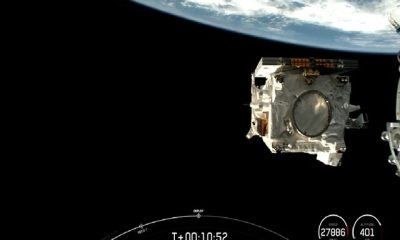


Launching a satellite to investigate the role of clouds in changing the Earth’s climate
-




How is the dark extinction quietly wiping out life on Earth?
-




What is global warming and what are its consequences?
-

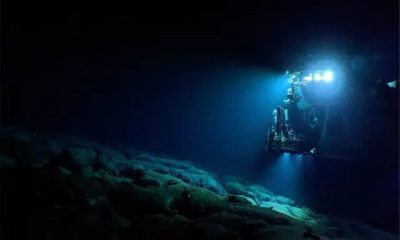


Discovery of new hydrothermal wells at a depth of 2.5 km in the ocean
-




Climate change slows down the rotation of the earth!
Environment
If the dinosaurs did not become extinct, what would our world be like today?
Published
1 month agoon
26/07/2024

If the dinosaurs did not become extinct, what would our world be like today?
Sixty-six million years ago, an asteroid with the power of 10 billion atomic bombs hit Earth and changed the course of evolution forever. The sky became dark and the photosynthesis of plants stopped. First, the plants and then the animals that fed on them were destroyed, the food chain collapsed and more than 90% of the species disappeared. As the dust settled in the Earth’s atmosphere, all dinosaurs became extinct except for a group of birds. But this catastrophic event paved the way for human evolution. The surviving mammals, especially the early primates, multiplied, and then humans evolved.
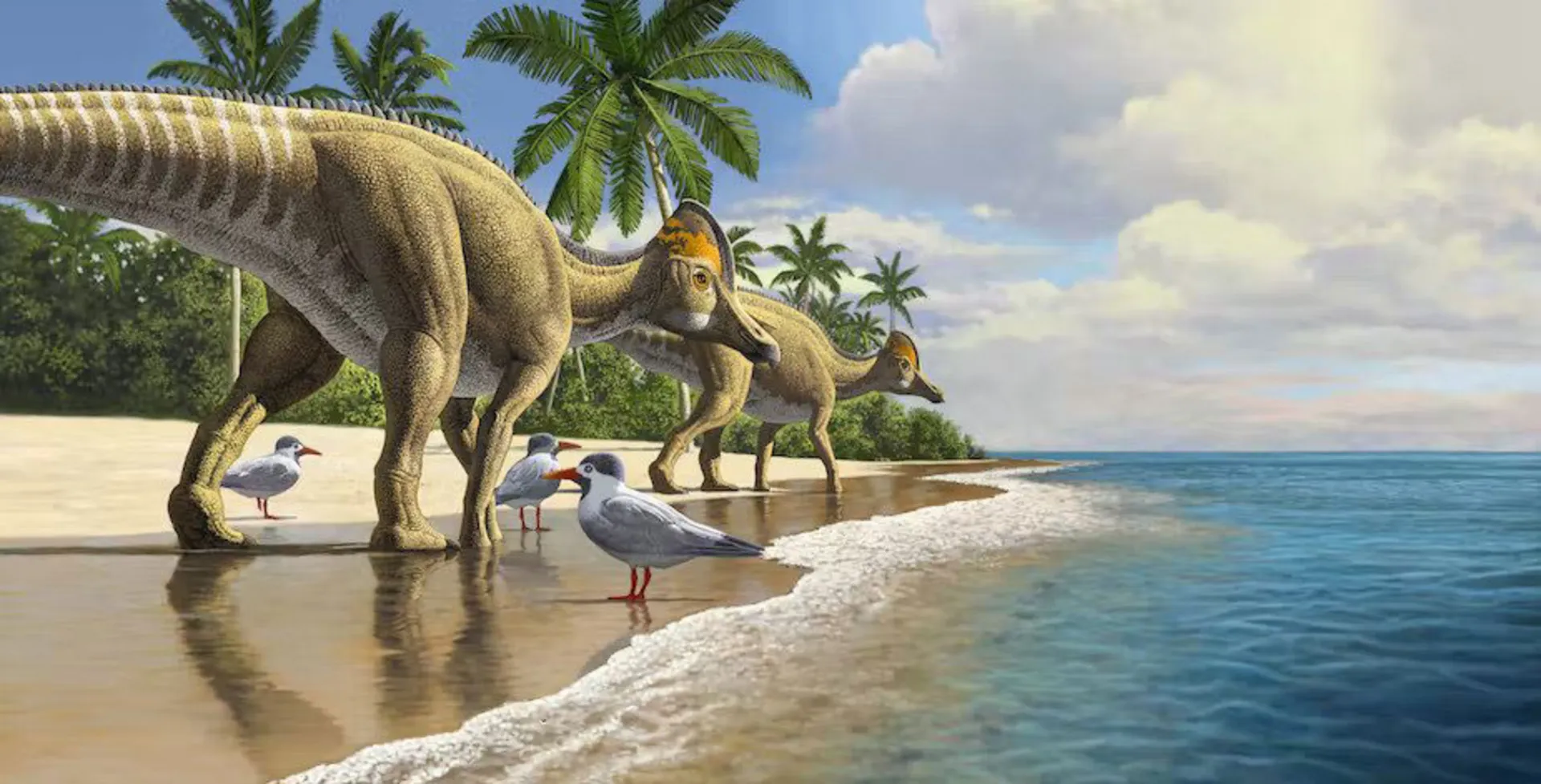
Strangely, Odysseus lived about 66 million years ago and was one of the last dinosaurs on earth.
Now suppose that the said asteroid had not hit the earth and the dinosaurs would have been saved. Imagine evolved raptors flying their flag on the moon. Dinosaur scientists discover relativity or discussing a hypothetical world dominated by mammals.
This hypothesis may seem like a science fiction story, but it contains deep philosophical questions about evolution. Did humans evolve purely by chance, or was the evolution of intelligent tool-using creatures inevitable?
Brains, tools, language, and large social groups have made humans the dominant species on the planet. Eight billion wise humans (homosapiens) live on the seven continents of the earth. According to the same weight, the number of humans is more than all the wild animals in the world. Humans have changed half of the earth’s land to feed themselves. In the 1980s, paleontologist Dale Russell proposed a thought experiment in which a carnivorous dinosaur evolved into an intelligent, tool-using creature. This dinosauroid has a big brain and walks on two legs.

Dinosauroid model
This hypothesis is not impossible but unlikely. The biology of an animal limits its evolutionary path. Your starting point determines your ending point. If you get kicked out of college, you can’t become a brain surgeon, a lawyer, or a NASA rocket scientist; But you may become an artist, actor, or entrepreneur. The paths we take in life open doors and close others. This also applies to evolution.
For example, consider the dimensions of dinosaurs. Sauropod dinosaurs, such as Brontosaurus and its relatives, weighed 30-50 tons and grew up to 30 meters in length during the Jurassic period. Their weight was ten times the weight of current elephants and their length was as long as a blue whale. This evolution has been seen in several groups such as Diplodocidae, Brachiosaurdiea, Turiasaurdiea, Mamenchisaurdiae, and Titanosauria.

Giant dinosaurs and mammals through time
This evolutionary process was also repeated in different continents at different times and in diverse climates from deserts to rainforests, But the other dinosaurs that lived in these environments did not become gigantic giants. The common point of all the above dinosaurs was that they were all sauropods. Anatomical features of sauropods, such as lungs, hollow bones with a high strength-to-weight ratio, metabolism, or all of these, enhanced their evolutionary potential. In this way, these dinosaurs grew in an unprecedented way.
On the other hand, carnivorous dinosaurs evolved into multi-ton hunters with huge ten-meter bodies. During more than 100 million years, megalosaurids, allosaurids, carcharodontosaurids, neovenatorids, and finally tyrannosaurs evolved into giant apex predators.
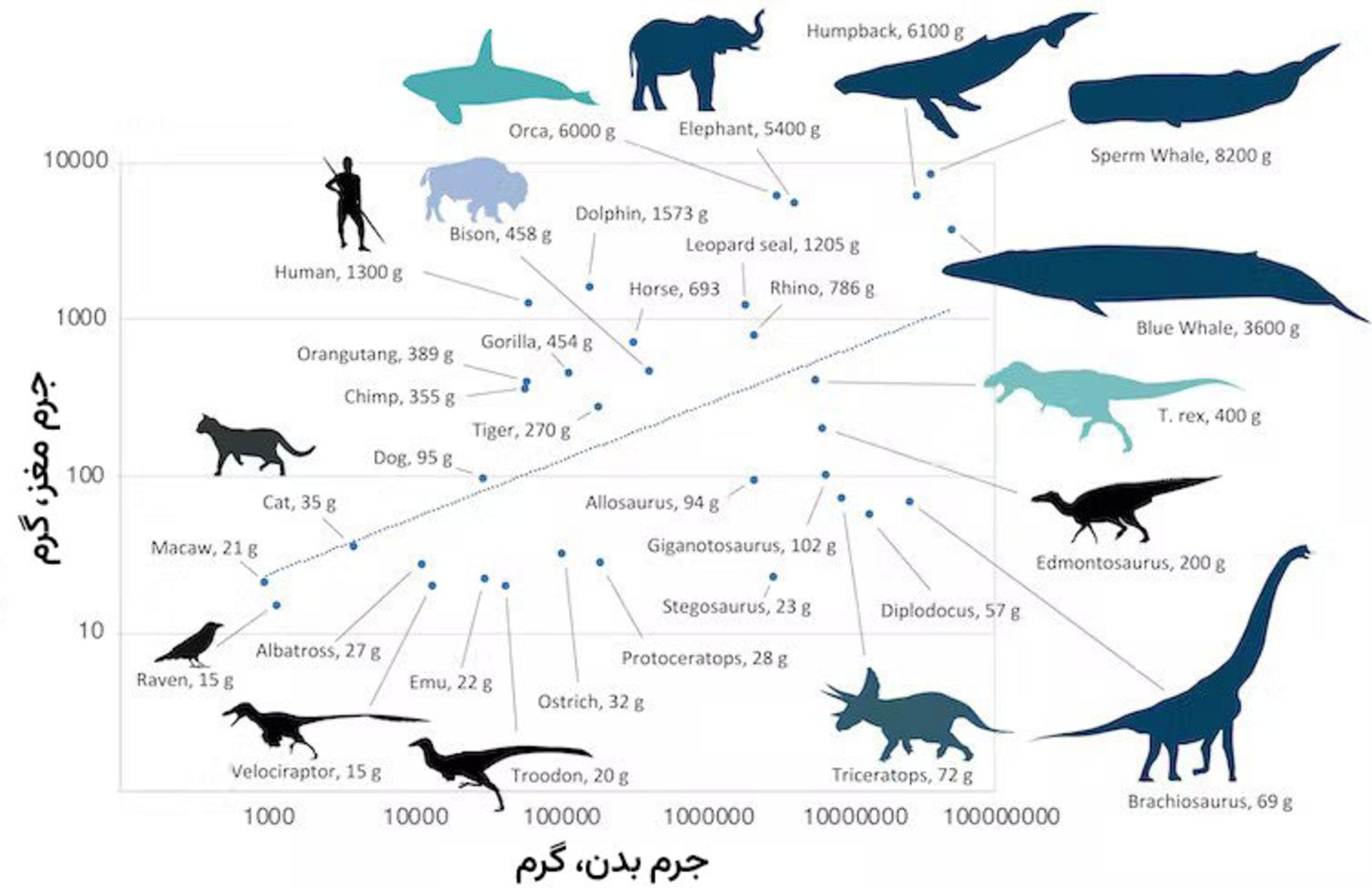
Brain size relative to body mass in dinosaurs, mammals, and birds
Dinosaurs had huge bodies, But they did not have a big brains. In fact, dinosaur brains rarely grew over time. Jurassic dinosaurs such as Allosaurus, Stegosaurus, and Brachiosaurus had small brains. 80 million years later, in the late Cretaceous period, tyrannosaurus and duck-billed dinosaurs evolved with larger brains; But the weight of the T-Rex brain, despite its gigantic body, was only 400 grams. The brain of Volareceptor was only 15 grams. Meanwhile, the average weight of the human brain reaches 1.3 kg.
Dinosaurs entered a new era over time. Small herbivores became more common and bird biodiversity increased. Later long-legged species evolved. It also seems that dinosaurs had a complex social life. They began a herd life and evolved with heavy horns for fighting. However, dinosaurs seem to have replicated themselves, usually evolving into giant herbivores and small-brained carnivores.
In the span of 100 million years of the history of dinosaurs, no trace of progress can be seen in them. Giant long-necked herbivores and massive tyrannosaur-like predators recurred during this interval. Maybe dinosaurs’ brains got a little bigger over time, but there is little evidence for their evolution into geniuses. It is even unlikely that mammals would have banished them. Dinosaurs were one of the dominant species in their environment until the asteroid hit.
However, mammals had different limitations. They never evolved into giant herbivores and carnivores. Rather, they repeatedly evolved with larger brains. Examples of large brains (human brain size or larger) are seen in orcas, sperm whales, baleen whales, elephants, leopards, and monkeys.

Golden lion tamarin, South American monkey
Today, few descendants of dinosaurs (birds such as crows and parrots) have complex brains. They can use tools, talk, and count; But mammals such as monkeys, elephants, and dolphins evolved with larger brains and more complex behaviors; So can we say that the elimination of dinosaurs ensured the evolution of mammalian intelligence? maybe not
The starting point can determine the ending point, but it cannot guarantee it. Steve Jobs, Bill Gates, and Mark Zuckerberg were all expelled from the university; But not every expulsion from the university leads to this fate. Even if you start at the right point, you need opportunity and luck to continue. The evolutionary history of primates shows that our evolution was not inevitable. African primates evolved in the form of monkeys with big brains in a span of seven million years and ended up with modern humans, But the evolution of primates took a different path in other places.
When monkeys arrived in the Americas about 35 million years ago, they evolved into other monkey species, and primates arrived in North America at least three separate times, 55 million, 50 million, and 20 million years ago. However, they did not become the species that made weapons and smartphones. Rather, they became extinct for reasons we do not know.
Only in Africa did evolution take a unique path. Perhaps something special about the fauna and flora or the geography of Africa caused apes to take a different evolutionary path and become tool-using primates with large bodies and brains. Even with the extinction of the dinosaurs, human evolution required the right combination of opportunity and luck.
Environment
Launching a satellite to investigate the role of clouds in changing the Earth’s climate
Published
3 months agoon
29/05/2024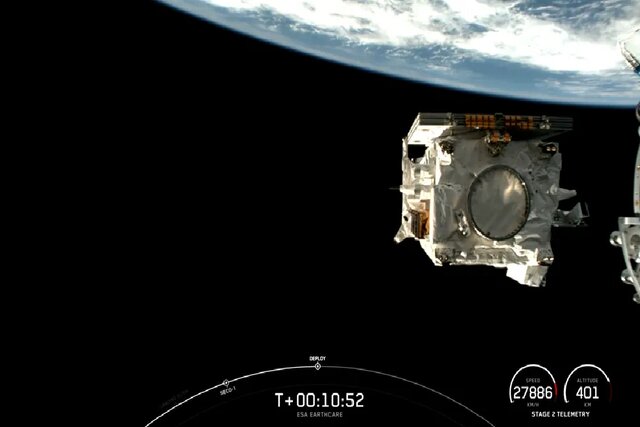

The satellite for investigating the role of clouds in the Earth’s climate, which is a joint mission between the European Space Agency and the Japan Aerospace Exploration Agency, was launched into the earth’s orbit by the Falcon 9 rocket of the SpaceX company.
Launching a satellite to investigate the role of clouds in changing the Earth’s climate
May 28 was a busy day for SpaceX.
According to Space, a SpaceX Falcon 9 rocket launched at 6:20 pm EST with the Cloud-Aerosol and Earth Radiation Probe or EarthCARE satellite from the base. Vandenberg Space Force took off in California.
The Earthcore satellite is a joint mission between the European Space Agency (ESA) and the Japan Aerospace Exploration Agency (JAXA). According to the European Space Agency, the mission will investigate the role of clouds and aerosols in reflecting sunlight into space and trapping infrared radiation emitted from the Earth’s surface.
The European Space Agency added: “Learning about the balance of solar radiation on our planet is very important to address climate problems, and it can only be done from space.”
This mission operates at the same orbital altitude as the International Space Station, but with a different program. Arthkar satellite will travel in a sun-synchronous polar orbit. The satellite will look at particles in clouds and aerosol molecules in the atmosphere to see how they interact with precipitation and how fast they fall to our planet.
The officials of the European Space Agency said: “Earthker” satellite will record the distribution of water droplets and ice crystals and how they move in the clouds. Inherent data will improve the accuracy of models of cloud development and their behavior, composition, and interaction with aerosols. Also, they improve future climate models and support numerical weather forecasting.
This satellite has four types of scientific equipment, which include an atmospheric lidar for detailed investigation of clouds and cloud and aerosol characteristics, a cloud-characterizing radar for learning about the movement dynamics and structure of clouds, a broadband radiometer for investigating solar radiation and infrared radiation, and a Multispectral imager.
Arthkar satellite was designed for the first time in 2004 and was designed and built by Airbus and 75 subsidiary companies.
European Space Agency Director General Josef Aschbacher said: I am relieved that the launch was successful. I am very happy for all the people who have worked on this project for decades. I know how much blood, sweat, and tears have gone into this mission to get to where it is today.
Simonetta Cheli, the current director of the European Space Agency’s Earth observation programs, believes that although this satellite was first designed 20 years ago, it appears more relevant today than imagined.
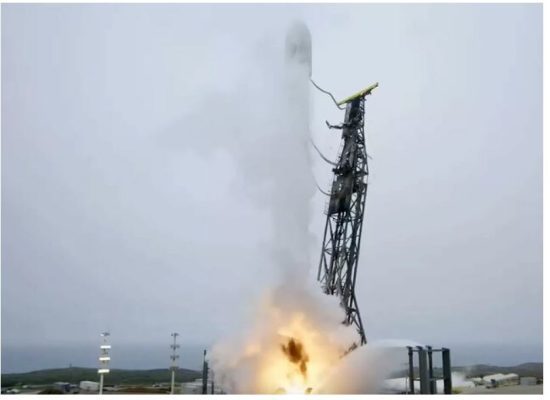

“Earthcare’s mission showcases the relevance of environmental sustainability and shows that climate, in general, is something that is at the top of our member countries’ agenda, both in terms of support programs and participation in projects, as well as the continuation of existing data,” Chelley said. We found that last year was the hottest year on record. Also, all months of 2024 were the warmest on record.
He added: If we want to evaluate the sun’s radiation towards the earth and examine the effect of clouds in terms of cooling, it is necessary to have accurate and innovative information about clouds, aerosols, and precipitation. All of these issues can be explored in more depth today with the data obtained from the four EarthKer satellite instruments.
After launch, Earthcore is expected to undergo a six-month commissioning period, and its initial mission is expected to last at least three years.
Read more: Climate change slows down the rotation of the earth!
This was the second launch of May 28 for SpaceX. The company launched a group of its Starlink internet satellites into Earth orbit this morning from Cape Canaveral Space Force Base in Florida.
According to the SpaceX mission description, the Falcon 9 first-stage booster that was flown in this mission has reached space seven times so far. Among its previous missions, was the launch of the “Dragon” manned capsule in the “Crew-7” mission to the “International Space Station”, the cargo flight of “CRS-29” to the International Space Station. And there were two Starlink missions.
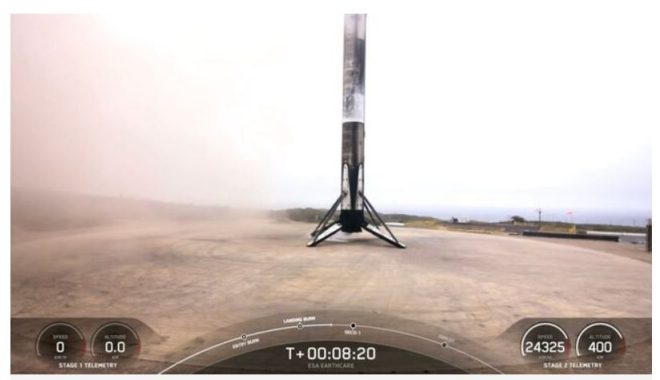

The first stage of the “Falcon 9” rocket was placed on the landing platform shortly after the launch of the “Arthkar” satellite.
The mission booster successfully landed at Vandenberg Space Force Base on May 28, approximately eight minutes after launch. About 2.5 minutes later, the Falcon 9 upper stage placed the Erthkar satellite into orbit as planned.
Environment
How is the dark extinction quietly wiping out life on Earth?
Published
3 months agoon
27/05/2024

How is the dark extinction quietly wiping out life on Earth?
One of the creatures on earth is gone forever, but we don’t know what it is. Like trees falling to the ground in the silence of an empty forest, entire species disappear without anyone witnessing or even realizing their existence. This phenomenon, known as the “dark extinction,” severely undermines our ability to catalog the world’s biodiversity or understand human impact on the web of life on Earth.
What is dark extinction?
The term dark extinction refers to the extinction of species that we don’t even know exist. In other words, the term is used for life forms that become extinct before we can discover or scientifically describe them. These creatures do not find their place in the classification system of living things on Earth.
Typically, the label dark extinction is applied to those plants and animals that have disappeared as a direct result of human-induced habitat changes. Therefore, undiscovered dinosaurs do not count as the dark extinction. However, unknown extinctions are not limited to the modern age and also go back to prehistoric times, when our ancestors first occupied the world’s continents and hunted some of the large animals to extinction.
The term dark extinction refers to the extinction of species that we don’t even know exist
Many human-caused extinctions of large animals are well represented in the fossil record, however, there are probably a few large animal extinctions in the past ten thousand years that we are not aware of.
A major wave of human-caused extinction began around the 14th century across the planet. It was at this time that advances in European maritime technology allowed Westerners to go to remote oceanic islands and bring rats, cats, and other non-native mammals to new lands and destroy native life. Since this period was before the classification of animals at the beginning of the 19th century, many species that disappeared during this period were not scientifically described or recorded in any catalog, meaning that we do not know how many species were lost.

Even since the beginning of the classification period, an unknown number of species have disappeared before anyone had a chance to record their existence. Many of these life forms disappeared without a trace, and others left behind fossils that were discovered after the extinction or have yet to be discovered.
“Great unknowns are things that went extinct before the science of taxonomy began,” Dr. Alexander Lees of Manchester Metropolitan University told IFL Science.
To fill in all the blanks, we’d have to find the remains of any extinct species, though that’s highly unlikely. For many species we have to resort to fossils. Thus, species that fossilize well may have a better record of historical extinctions. For example, birds do not fossilize as well as mammals, and most invertebrates are rare in the fossil record. In other words, we don’t really know how many dark extinctions have occurred throughout human history, although scientists have speculated and the numbers are staggering.
How many species are extinct?
The official IUCN list of extinct flora and fauna currently includes only 909 species. However, this figure is an understatement because it does not account for unknown extinctions or undiscovered species.
Researchers have attempted to develop statistical models to calculate the number of dark extinctions that accompanied these confirmed extinctions. For example, the results of a study have shown that about 1430 species of birds may have disappeared due to human activities, while another study shows that 60% of the total extinctions in some groups of animals may be undiscovered species. Another paper concluded that we may have lost 260,000 species of invertebrates over the past 500 years.
We do not know that there have been several dark extinctions throughout human history
All of the above estimates are very approximate and mostly guesswork, in the sense that we don’t really have any exact numbers to represent all the creatures that disappeared from the face of the earth.
While there have been theoretical studies of dark extinctions, every now and then scientists find actual physical evidence for the phenomenon, and most of them show how wrong our numerical estimates have been. For example, in 2013 a lineage of extinct land snails was discovered in French Polynesia, increasing the total number of confirmed mollusk extinctions by about two percent.
Given that most estimates of dark extinction are based on extrapolations of known extinctions, such findings can have a significant impact on statistical modeling.
Each newly confirmed historical extinction opens up endless possibilities for the loss of companion species that may have been associated with the extinct species, Lee explains. On the other hand, while it may be easy to identify large ancient animals in the fossil record when it comes to the parasites that lived in the bodies of these species, as well as the creatures that consumed their feces, we realize how much we know about We are unaware of the species that have been lost.
How can we prevent the dark extinction?
Extinction is an integral part of the process of natural selection, and even without the help of humans, the world is thought to lose about one species per million each year, known as the background extinction rate.
Current estimates suggest that the world is losing species thousands of times faster than the background extinction rate, leading to the suggestion that we are in the midst of the planet’s sixth mass extinction. Therefore, it is clear that we have not been successful in protecting Earth’s biodiversity, and if we are to reverse this trend, we need major investments in habitat protection now.

Nowhere on Earth is the condition of species destruction more urgent than in the Brazilian Atlas Forest; Where there is the highest abundance of endangered vertebrates in the Americas. This forest, which once covered 1.2 million square kilometers of land, is now reduced to small patches that cannot help sustain the species’ population. “A pair of species might live in the same patch of forest, but there’s no genetic sharing between the patches, and if one of those mojowats is lost, we’ll lose that species,” Liz explains.
86% of terrestrial organisms and 91% of marine organisms have not yet been officially discovered
The problem is so severe that Lees believes many of the region’s threatened species are unlikely to survive in captivity without breeding programs. However, these efforts will be fruitless if there is no immediate plan to rehabilitate forest patches create connections between them, and increase the size of those patches.
Out-of-habitat breeding and propagation programs are designed to save known species but do not directly contribute to mitigating the dark extinction crisis. However, by restoring habitats, we can indirectly bring many undiscovered species back from the brink of extinction.
If we have a more complete list of the world’s inhabitants, the dark extinction will no longer make sense. We may not be able to prevent the extinction of many of these species, but if we describe them all, at least we know what we are missing.
There are thought to be about 8.7 million animal species on Earth, and in more than two centuries of taxonomy, we have described only about 1.2 million of them. According to some calculations, 86% of all terrestrial organisms and 91% of organisms that live in the ocean have not yet been officially discovered.
It is clear that we need to discover the diversity of life, but the pace of work is slow and the science of taxonomy is no longer very popular. “We want to catalog Earth’s biodiversity before it goes extinct, but it’s really slow because there’s not a lot of funding going into taxonomy,” says Lees. The more organisms we identify, the fewer extinctions will fall into the dark category. “You will never be able to find and describe all the creatures, but we hope to reach the target above ten percent.”


The James Webb Space Telescope; A look at the vastness of the universe


Hubble Space Telescope; A portal to the mysterious depths of the universe
Moons of Saturn; Features and Explorations


Moons of Jupiter; Features and Explorations


Ten strange moons of the solar system


Apple Aesthetics; A look at the history of iPhone design


5 exciting features of Windows 11 2024 update


What is a nebula? Everything you need to know about it


Problems that technology has not yet solved after 20 years


Canopus; What do we know about the second brightest star in the sky?
Popular
-



 Technology1 year ago
Technology1 year agoWho has checked our Whatsapp profile viewed my Whatsapp August 2023
-



 Technology1 year ago
Technology1 year agoSecond WhatsApp , how to install and download dual WhatsApp August 2023
-



 Technology1 year ago
Technology1 year agoHow to use ChatGPT on Android and iOS
-



 AI2 years ago
AI2 years agoUber replaces human drivers with robots
-



 Technology1 year ago
Technology1 year agoThe best Android tablets 2023, buying guide
-



 Technology1 year ago
Technology1 year agoThe best photography cameras 2023, buying guide and price
-



 Humans2 years ago
Humans2 years agoCell Rover analyzes the inside of cells without destroying them
-



 Technology1 year ago
Technology1 year agoHow to prevent automatic download of applications on Samsung phones

